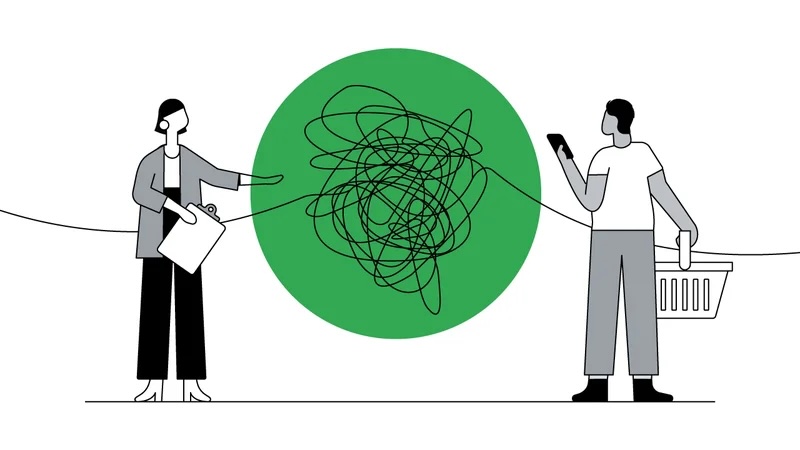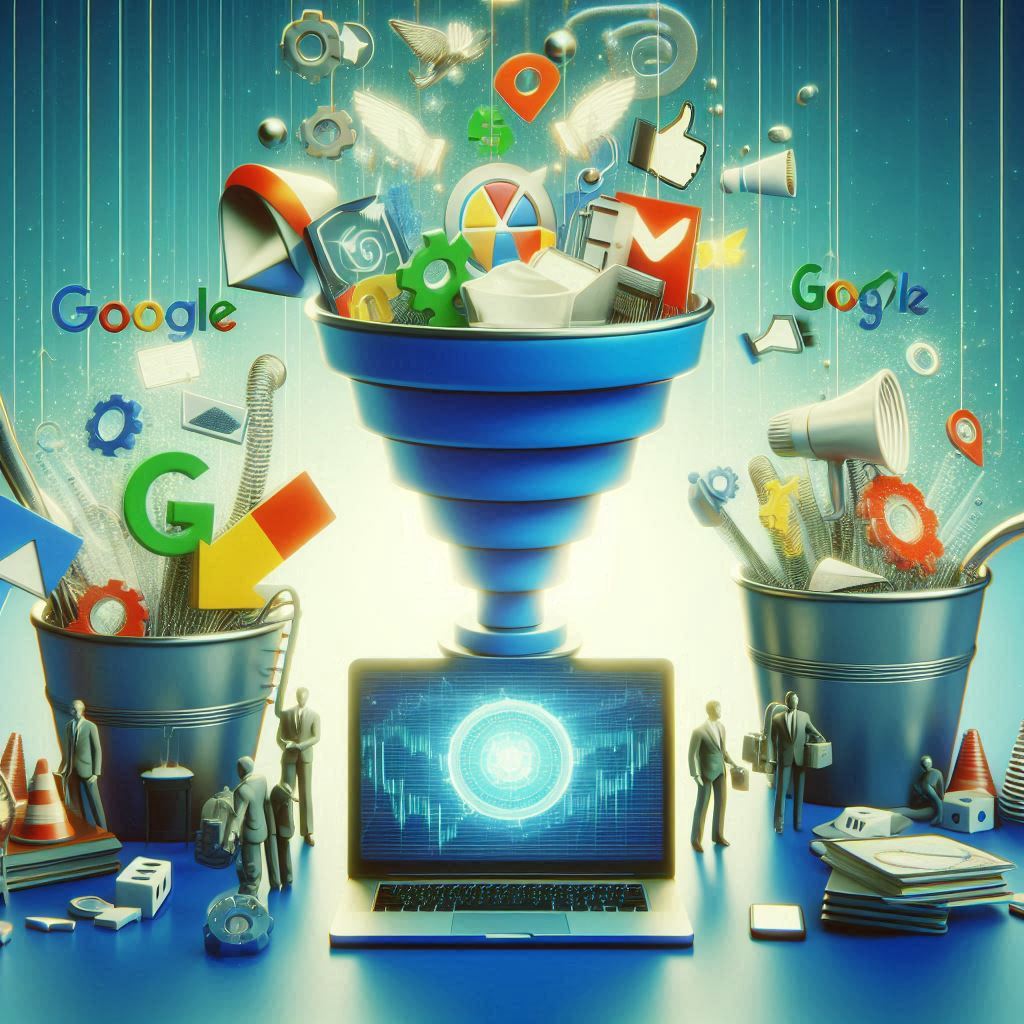The traditional marketing funnel depicted a linear journey from awareness to consideration to decision. But the customer journey has become a kind of a maze. The long-standing marketing concept of the traditional sales funnel has been rendered obsolete in today’s digital age. As consumer behavior evolves and technology advances, the path to purchase has become increasingly complex and non-linear. Today’s buying process, especially in B2B tech, is far more complex and non-linear. Google’s “messy middle” concept accurately captures this new reality. Question is now is the traditional funnel really replaced by the messy middle?
The Messy Middle Explained
Instead of a funnel, Google’s concept of the “messy middle” more accurately reflects today’s buying process. This model acknowledges that customers loop between exploration and evaluation before making a purchase decision. It recognizes the complexity of modern decision-making, influenced by various touchpoints and information sources.. This process is characterized by:
- Multiple touchpoints across various channels
- Back-and-forth movement between stages
- Influence from both internal and external factors
Jonny Protheroe and Sian Davies have been ‘decoding’ consumer decision-making since 2019. Their latest research from 2023 reveals where — and how — marketers can experiment and iterate to increase customer confidence and sales in the “messy middle” of the online purchase journey.

Lets look at some examples of a customer journey in traditional funnel from the “old” world compared with the messy middle, “new” reality.
B2B Tech Industry Examples – the old world
Microsoft’s Windows Operating System
In the 1990s and early 2000s, Microsoft employed a classic funnel approach for Windows:
- Awareness: Massive advertising campaigns on TV, print, and billboards.
- Interest: In-store displays and demo computers at retailers.
- Consideration: Detailed product brochures and comparison charts.
- Purchase: Boxed software sold through retail channels or pre-installed on new PCs.
This linear approach assumed customers moved sequentially through stages, with limited interaction or personalization.
IBM’s Enterprise Hardware
IBM’s traditional funnel for mainframe computers and servers:
- Awareness: Trade show presentations and industry publications.
- Interest: White papers and technical specifications.
- Consideration: On-site demonstrations and ROI calculations.
- Purchase: Direct sales through account executives.
This model relied heavily on in-person interactions and assumed a long, predictable sales cycle.
Adobe’s Creative Suite
Before moving to a subscription model, Adobe used a traditional funnel for its Creative Suite:
- Awareness: Print ads in design magazines and sponsorships of creative events.
- Interest: Free trials of individual products.
- Consideration: Comparison charts of different suite versions.
- Purchase: One-time purchase of boxed software through authorized resellers.
This approach focused on pushing customers towards a single, significant purchase decision.
B2B Tech Industry Examples – the NEW world
HubSpot
- HubSpot has excelled in addressing the messy middle through its comprehensive inbound marketing approach:
- Content for Every Stage: They produce a vast array of content, from blog posts and ebooks to webinars and tools, catering to both exploration and evaluation phases.
- Educational Focus: Their HubSpot Academy offers free courses and certifications, providing value throughout the customer journey.
- Social Proof: They prominently feature customer success stories and case studies across their marketing channels.
Salesforce
- Salesforce has implemented several strategies to guide prospects through the messy middle:
- Trailhead Platform: This free, gamified learning platform keeps Salesforce top-of-mind while prospects explore and evaluate options.
- AppExchange Marketplace: By offering a robust ecosystem of third-party integrations, Salesforce addresses diverse needs during the exploration phase.
- Personalized Demo Experiences: They offer tailored product demonstrations based on industry and role, catering to specific evaluation criteria.
Zoom
- Zoom’s approach to the messy middle focuses on simplicity and accessibility:
- Freemium Model: Their free tier allows prospects to explore and evaluate the product extensively before committing.
- Webinar Series: They host regular webinars addressing various use cases, supporting both exploration and evaluation.
- Integration Ecosystem: Zoom’s extensive integrations with other business tools help it remain in consideration throughout the decision process.
DocuSign
- DocuSign has adapted to the messy middle by emphasizing trust and versatility:
- Industry-Specific Solutions: They offer tailored solutions for various sectors, addressing specific needs during evaluation.
- Trust Center: A dedicated section of their website provides security and compliance information, crucial for evaluation in regulated industries.
- API and Integration Focus: By highlighting their extensibility, DocuSign remains relevant as prospects explore various workflow solutions.Cloud Software Adoption
A company looking to adopt a new cloud platform might:
Advice for Marketers
To navigate from traditional funnel to (maybe) replace this with the messy middle effectively:
- Create Diverse Content: Develop a range of content types addressing different stages of the buyer’s journey, from educational blog posts to detailed comparison guides.
- Leverage Social Proof: Prominently feature customer testimonials, case studies, and success stories across marketing channels.
- Offer Free Value: Provide free tools, trials, or educational resources to keep prospects engaged throughout their decision process.
- Personalize Experiences: Tailor content, demos, and communications based on industry, role, and specific pain points.
- Build an Ecosystem: Develop integrations and partnerships to remain relevant as prospects explore various solutions.
- Address Trust and Security: Provide transparent information about security, compliance, and reliability to support evaluation.
- Implement Retargeting: Use smart retargeting strategies to stay top-of-mind as prospects move between exploration and evaluation.
- Embrace Omnichannel: Ensure consistent messaging and experiences across all touchpoints, from website to social media to sales interactions.
By embracing the messy middle concept, B2B tech marketers can create more effective strategies that align with the reality of modern buying behaviors, ultimately driving better results and stronger customer relationships.
Conclusion is the traditional funnel really replaced by a messy middle?
In my experienced it still is a mix of both worlds, there is no more clear guideline, “customer stream”, straight customer journey with a clear direction. Customers are jumping back and forth and sideways in their buying process.
BUT there is a clear goal we want to achieve: help the customer to find to our website, service, products.
This means we need to define the paths, the possible sideways, be where the customers are, answer customers questions, need to know the job to be done. Then we can guide the customer into a direction through the messy middle, show the path through this jungle.
Here is another link that can help: mapping-out-your-customer-journey-effectively



